Cloud Storage Adoption Report: Telelink's Cloud Solution Analysis
VerifiedAdded on 2022/10/08
|18
|4488
|51
Report
AI Summary
This report provides a comprehensive analysis of cloud storage adoption for Telelink, a medium-sized telecommunications company based in Auckland, New Zealand. The study investigates the current on-premise server environment and its limitations, including data storage challenges and security concerns. It details the evaluation and selection process of a cloud solution, focusing on Amazon Web Services (AWS) and its various services like EC2, Auto Scaling, Elastic Load Balancing, Workspaces, VPC, Route 53, and RDS. The report outlines the methodology for migrating from the on-premise system to the cloud, along with a cost, investment, and strategic opportunities analysis. It validates the business case for cloud adoption, highlighting the benefits such as simplified platform, scalability, agility, speed, security, and reliability. The conclusion summarizes the key findings and recommendations for Telelink's cloud storage implementation.

Running head: CLOUD STORAGE ADOPTION
CLOUD STORAGE ADOPTION
Name of student
Name of university
Author’s note:
CLOUD STORAGE ADOPTION
Name of student
Name of university
Author’s note:
Paraphrase This Document
Need a fresh take? Get an instant paraphrase of this document with our AI Paraphraser
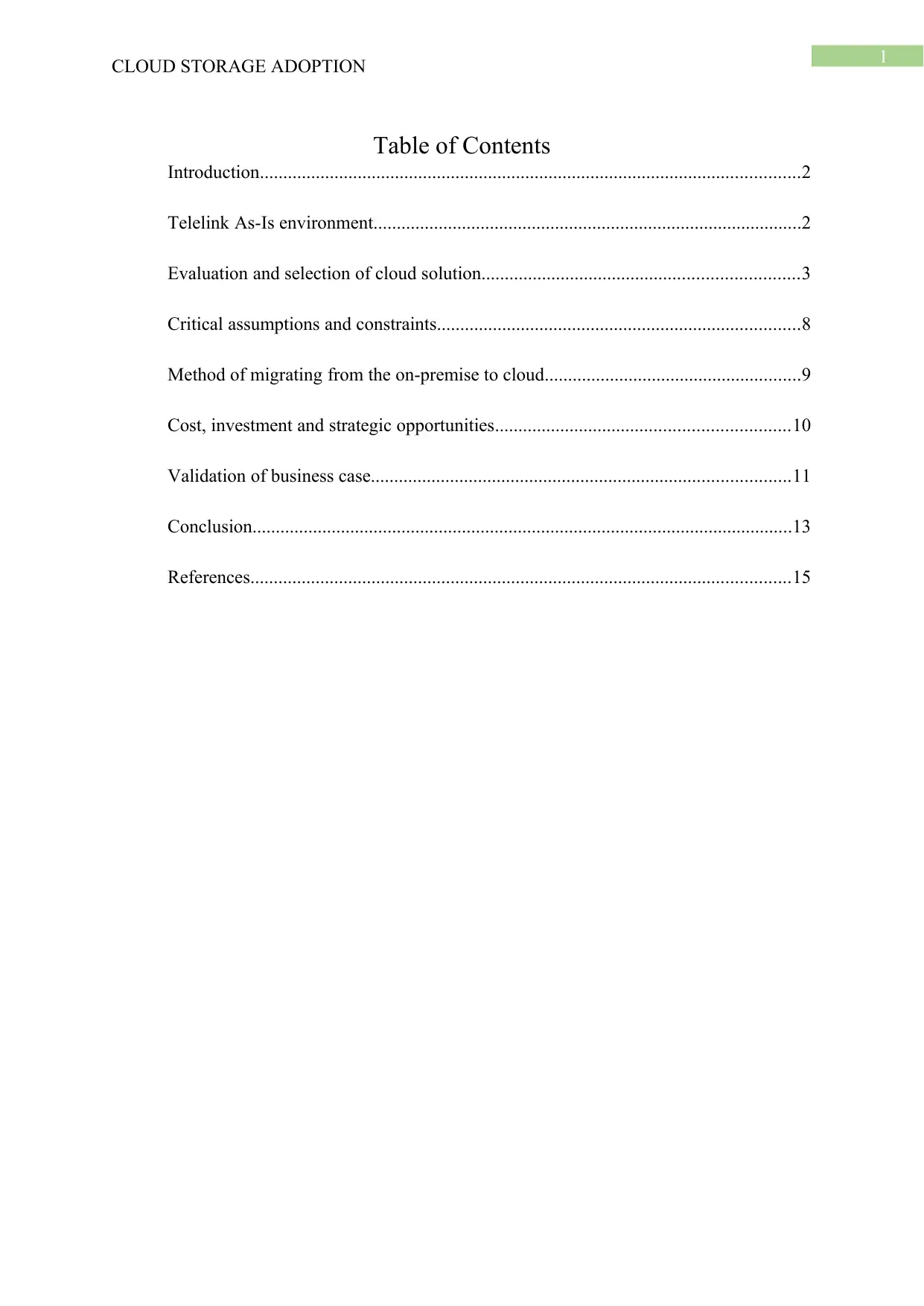
1
CLOUD STORAGE ADOPTION
Table of Contents
Introduction....................................................................................................................2
Telelink As-Is environment............................................................................................2
Evaluation and selection of cloud solution....................................................................3
Critical assumptions and constraints..............................................................................8
Method of migrating from the on-premise to cloud.......................................................9
Cost, investment and strategic opportunities...............................................................10
Validation of business case..........................................................................................11
Conclusion....................................................................................................................13
References....................................................................................................................15
CLOUD STORAGE ADOPTION
Table of Contents
Introduction....................................................................................................................2
Telelink As-Is environment............................................................................................2
Evaluation and selection of cloud solution....................................................................3
Critical assumptions and constraints..............................................................................8
Method of migrating from the on-premise to cloud.......................................................9
Cost, investment and strategic opportunities...............................................................10
Validation of business case..........................................................................................11
Conclusion....................................................................................................................13
References....................................................................................................................15

2
CLOUD STORAGE ADOPTION
Introduction
Presently, with the increase of data in the companies, the requirement of additional
storage space is increasing immensely. The companies intend to store all their data in the
central storage from where the data could be accessed easily by all the authenticated users.
The considered case study of the Telelink is presently considering the implementation of the
cloud storage in the organisation for storing all the data in a central place. The business is a
medium sized telecommunications company that is based in Auckland. The company mainly
conducts several surveys, takes the product orders, mails out all the information kits, and it
mainly offers efficient reception as well as 0800 services. The company has efficiently grown
to be among the largest contact centres in New Zealand.
Telelink As-Is environment
The present technology that is used is the on-premise servers that are connects all the
devices of the company in a central and it is used by the organisation for storing all the data.
The present architecture of the company is facing significant difficulties in providing the
required information to the employees whenever it is required. As the number of customers
of the business have increased, the company is facing significant difficulties in managing all
the information of the customers in their database. The company is also facing major threats
of data theft and this has led to the increase of the need for implementing secured storage
location.
The present TCO of the company is significant high as the company needs several
employees for the management of the servers of the company and ensure that all the data of
the company is secured efficiently. The data of the company is managed in the database
server where additional security has been introduced for maintaining the security of the
servers.
CLOUD STORAGE ADOPTION
Introduction
Presently, with the increase of data in the companies, the requirement of additional
storage space is increasing immensely. The companies intend to store all their data in the
central storage from where the data could be accessed easily by all the authenticated users.
The considered case study of the Telelink is presently considering the implementation of the
cloud storage in the organisation for storing all the data in a central place. The business is a
medium sized telecommunications company that is based in Auckland. The company mainly
conducts several surveys, takes the product orders, mails out all the information kits, and it
mainly offers efficient reception as well as 0800 services. The company has efficiently grown
to be among the largest contact centres in New Zealand.
Telelink As-Is environment
The present technology that is used is the on-premise servers that are connects all the
devices of the company in a central and it is used by the organisation for storing all the data.
The present architecture of the company is facing significant difficulties in providing the
required information to the employees whenever it is required. As the number of customers
of the business have increased, the company is facing significant difficulties in managing all
the information of the customers in their database. The company is also facing major threats
of data theft and this has led to the increase of the need for implementing secured storage
location.
The present TCO of the company is significant high as the company needs several
employees for the management of the servers of the company and ensure that all the data of
the company is secured efficiently. The data of the company is managed in the database
server where additional security has been introduced for maintaining the security of the
servers.
⊘ This is a preview!⊘
Do you want full access?
Subscribe today to unlock all pages.

Trusted by 1+ million students worldwide
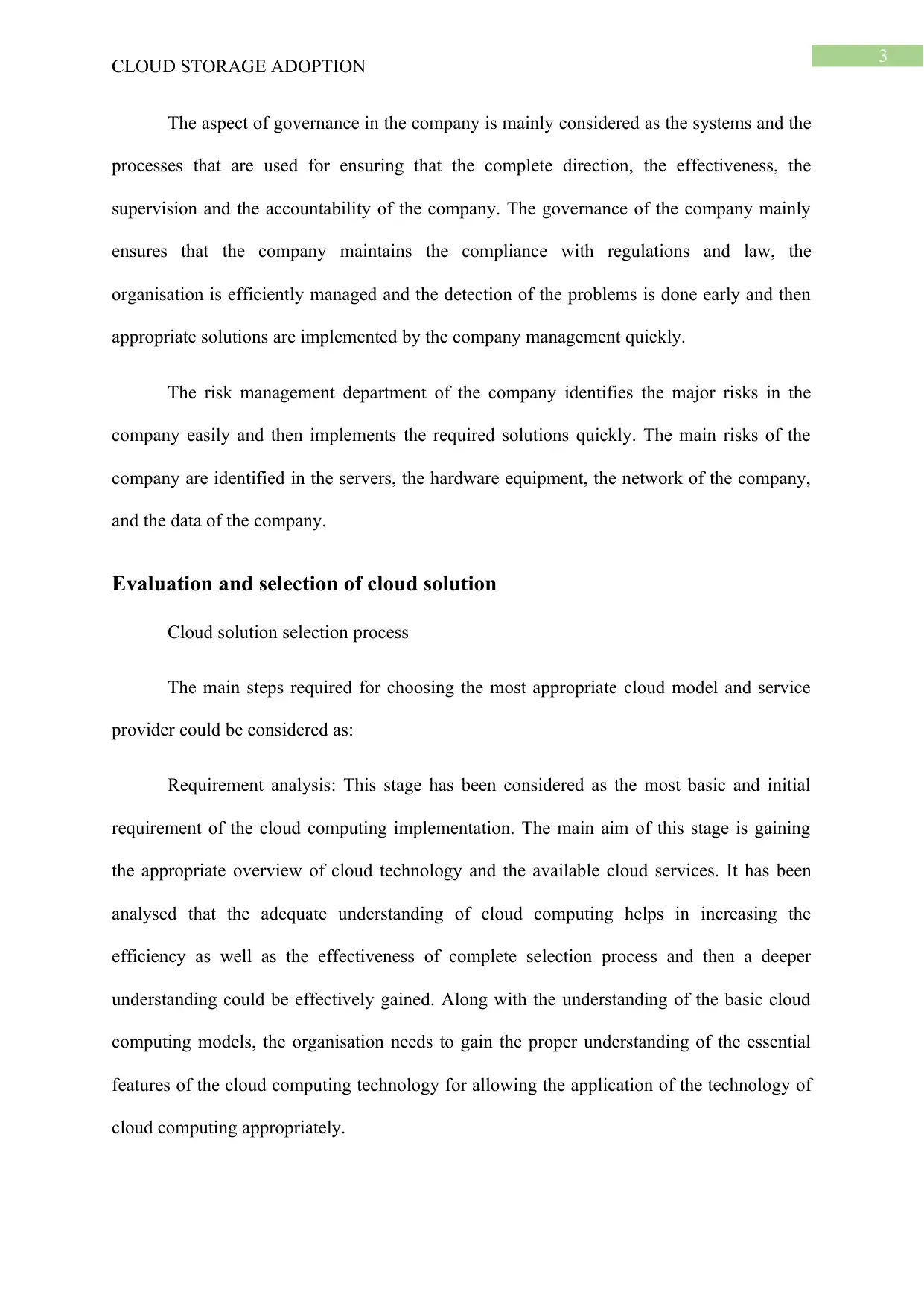
3
CLOUD STORAGE ADOPTION
The aspect of governance in the company is mainly considered as the systems and the
processes that are used for ensuring that the complete direction, the effectiveness, the
supervision and the accountability of the company. The governance of the company mainly
ensures that the company maintains the compliance with regulations and law, the
organisation is efficiently managed and the detection of the problems is done early and then
appropriate solutions are implemented by the company management quickly.
The risk management department of the company identifies the major risks in the
company easily and then implements the required solutions quickly. The main risks of the
company are identified in the servers, the hardware equipment, the network of the company,
and the data of the company.
Evaluation and selection of cloud solution
Cloud solution selection process
The main steps required for choosing the most appropriate cloud model and service
provider could be considered as:
Requirement analysis: This stage has been considered as the most basic and initial
requirement of the cloud computing implementation. The main aim of this stage is gaining
the appropriate overview of cloud technology and the available cloud services. It has been
analysed that the adequate understanding of cloud computing helps in increasing the
efficiency as well as the effectiveness of complete selection process and then a deeper
understanding could be effectively gained. Along with the understanding of the basic cloud
computing models, the organisation needs to gain the proper understanding of the essential
features of the cloud computing technology for allowing the application of the technology of
cloud computing appropriately.
CLOUD STORAGE ADOPTION
The aspect of governance in the company is mainly considered as the systems and the
processes that are used for ensuring that the complete direction, the effectiveness, the
supervision and the accountability of the company. The governance of the company mainly
ensures that the company maintains the compliance with regulations and law, the
organisation is efficiently managed and the detection of the problems is done early and then
appropriate solutions are implemented by the company management quickly.
The risk management department of the company identifies the major risks in the
company easily and then implements the required solutions quickly. The main risks of the
company are identified in the servers, the hardware equipment, the network of the company,
and the data of the company.
Evaluation and selection of cloud solution
Cloud solution selection process
The main steps required for choosing the most appropriate cloud model and service
provider could be considered as:
Requirement analysis: This stage has been considered as the most basic and initial
requirement of the cloud computing implementation. The main aim of this stage is gaining
the appropriate overview of cloud technology and the available cloud services. It has been
analysed that the adequate understanding of cloud computing helps in increasing the
efficiency as well as the effectiveness of complete selection process and then a deeper
understanding could be effectively gained. Along with the understanding of the basic cloud
computing models, the organisation needs to gain the proper understanding of the essential
features of the cloud computing technology for allowing the application of the technology of
cloud computing appropriately.
Paraphrase This Document
Need a fresh take? Get an instant paraphrase of this document with our AI Paraphraser
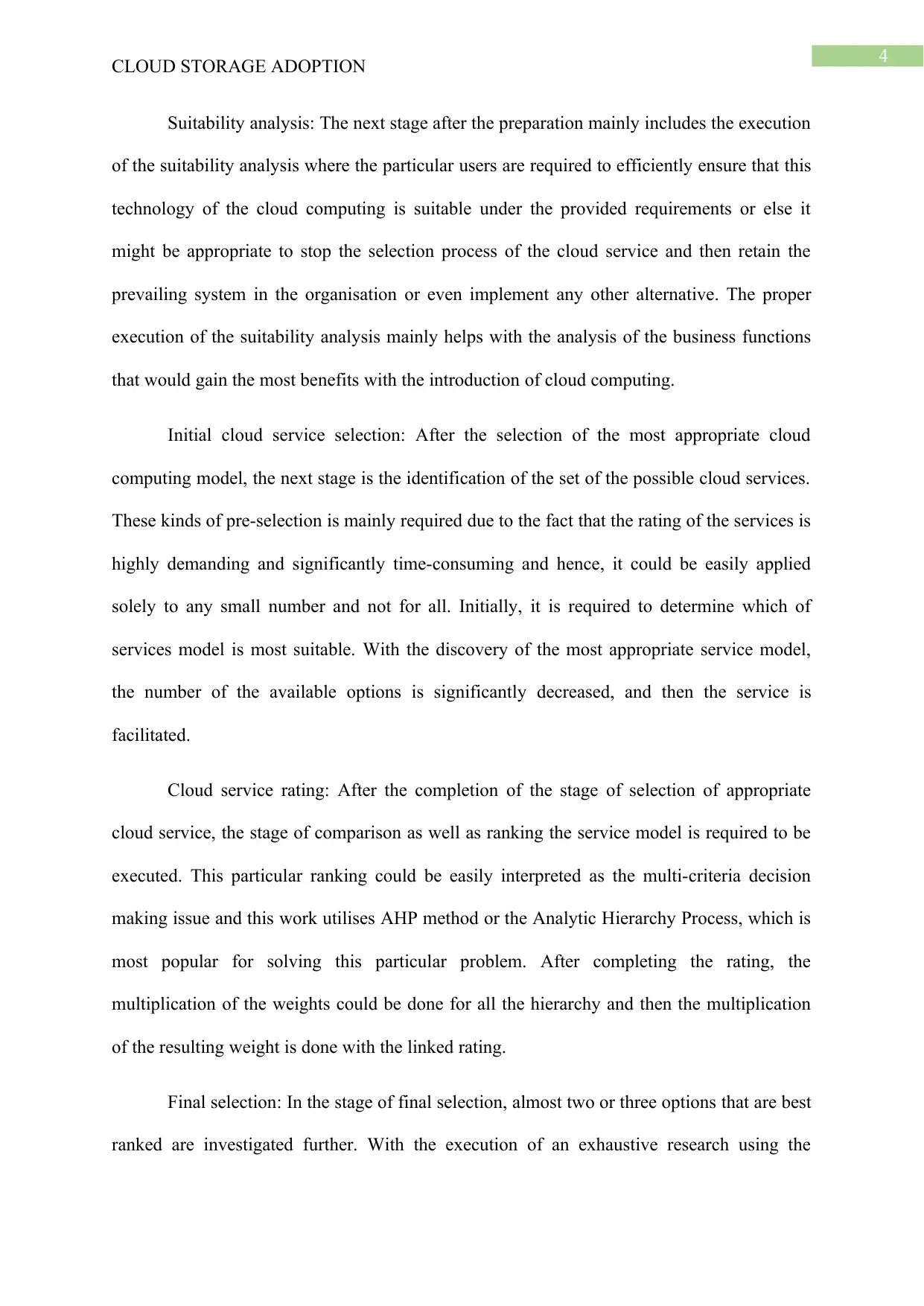
4
CLOUD STORAGE ADOPTION
Suitability analysis: The next stage after the preparation mainly includes the execution
of the suitability analysis where the particular users are required to efficiently ensure that this
technology of the cloud computing is suitable under the provided requirements or else it
might be appropriate to stop the selection process of the cloud service and then retain the
prevailing system in the organisation or even implement any other alternative. The proper
execution of the suitability analysis mainly helps with the analysis of the business functions
that would gain the most benefits with the introduction of cloud computing.
Initial cloud service selection: After the selection of the most appropriate cloud
computing model, the next stage is the identification of the set of the possible cloud services.
These kinds of pre-selection is mainly required due to the fact that the rating of the services is
highly demanding and significantly time-consuming and hence, it could be easily applied
solely to any small number and not for all. Initially, it is required to determine which of
services model is most suitable. With the discovery of the most appropriate service model,
the number of the available options is significantly decreased, and then the service is
facilitated.
Cloud service rating: After the completion of the stage of selection of appropriate
cloud service, the stage of comparison as well as ranking the service model is required to be
executed. This particular ranking could be easily interpreted as the multi-criteria decision
making issue and this work utilises AHP method or the Analytic Hierarchy Process, which is
most popular for solving this particular problem. After completing the rating, the
multiplication of the weights could be done for all the hierarchy and then the multiplication
of the resulting weight is done with the linked rating.
Final selection: In the stage of final selection, almost two or three options that are best
ranked are investigated further. With the execution of an exhaustive research using the
CLOUD STORAGE ADOPTION
Suitability analysis: The next stage after the preparation mainly includes the execution
of the suitability analysis where the particular users are required to efficiently ensure that this
technology of the cloud computing is suitable under the provided requirements or else it
might be appropriate to stop the selection process of the cloud service and then retain the
prevailing system in the organisation or even implement any other alternative. The proper
execution of the suitability analysis mainly helps with the analysis of the business functions
that would gain the most benefits with the introduction of cloud computing.
Initial cloud service selection: After the selection of the most appropriate cloud
computing model, the next stage is the identification of the set of the possible cloud services.
These kinds of pre-selection is mainly required due to the fact that the rating of the services is
highly demanding and significantly time-consuming and hence, it could be easily applied
solely to any small number and not for all. Initially, it is required to determine which of
services model is most suitable. With the discovery of the most appropriate service model,
the number of the available options is significantly decreased, and then the service is
facilitated.
Cloud service rating: After the completion of the stage of selection of appropriate
cloud service, the stage of comparison as well as ranking the service model is required to be
executed. This particular ranking could be easily interpreted as the multi-criteria decision
making issue and this work utilises AHP method or the Analytic Hierarchy Process, which is
most popular for solving this particular problem. After completing the rating, the
multiplication of the weights could be done for all the hierarchy and then the multiplication
of the resulting weight is done with the linked rating.
Final selection: In the stage of final selection, almost two or three options that are best
ranked are investigated further. With the execution of an exhaustive research using the

5
CLOUD STORAGE ADOPTION
internet might provide some essential insights regarding the solutions that are highest ranked
and it could lead to the most elaborated ultimate selection.
Overview of cloud service provider: The cloud service provider that have been
selected for Telelink is AWS or Amazon Web Services. The AWS is the comprehensive
platform of cloud services that provides the required computing capacity, delivery of content,
storage, as well as several other functionality that could be used by the organisation for
deploying the applications as well as services in significantly cost-effective manner with
major flexibility, scalability, as well as reliability (Newcombe et al. 2015). The AWS self
service mainly denotes that the users could proactively address the internal plans and then
react to any external when the selection is done (Amazon 2015). The Amazon Elastic
Compute Cloud could be considered as the web service that provides resizable capacity of
computation within cloud storage. It is mainly aimed for making web-scale computing
significantly easier for the system administrators and the developers (Wittig and Wittig
2015). The interface of Amazon EC2’s simple web service permits the organisation to gain
plus configure the required capacity by the use of minimum friction. It offers the total control
of the computation resources and allows the company to execute on the proven computing
environment of Amazon (Narula and Jain 2015).
The main feature of the AWS is feature of autoscaling. The autoscaling of the
Amazon web service permits the users to the scale the capacity of the cloud storage according
to requirement that are defined by the users (Villamizar et al. 2016). With the proper use of
the auto-scaling, the company could ensure that the number of the instances of Amazon EC2
increases seamlessly while the demand significantly spikes for maintaining extensive
performance and helps with decreasing it automatically during the decrease of demand for the
minimisation of costs (Basha, Jilani and Arun 2016).
CLOUD STORAGE ADOPTION
internet might provide some essential insights regarding the solutions that are highest ranked
and it could lead to the most elaborated ultimate selection.
Overview of cloud service provider: The cloud service provider that have been
selected for Telelink is AWS or Amazon Web Services. The AWS is the comprehensive
platform of cloud services that provides the required computing capacity, delivery of content,
storage, as well as several other functionality that could be used by the organisation for
deploying the applications as well as services in significantly cost-effective manner with
major flexibility, scalability, as well as reliability (Newcombe et al. 2015). The AWS self
service mainly denotes that the users could proactively address the internal plans and then
react to any external when the selection is done (Amazon 2015). The Amazon Elastic
Compute Cloud could be considered as the web service that provides resizable capacity of
computation within cloud storage. It is mainly aimed for making web-scale computing
significantly easier for the system administrators and the developers (Wittig and Wittig
2015). The interface of Amazon EC2’s simple web service permits the organisation to gain
plus configure the required capacity by the use of minimum friction. It offers the total control
of the computation resources and allows the company to execute on the proven computing
environment of Amazon (Narula and Jain 2015).
The main feature of the AWS is feature of autoscaling. The autoscaling of the
Amazon web service permits the users to the scale the capacity of the cloud storage according
to requirement that are defined by the users (Villamizar et al. 2016). With the proper use of
the auto-scaling, the company could ensure that the number of the instances of Amazon EC2
increases seamlessly while the demand significantly spikes for maintaining extensive
performance and helps with decreasing it automatically during the decrease of demand for the
minimisation of costs (Basha, Jilani and Arun 2016).
⊘ This is a preview!⊘
Do you want full access?
Subscribe today to unlock all pages.

Trusted by 1+ million students worldwide
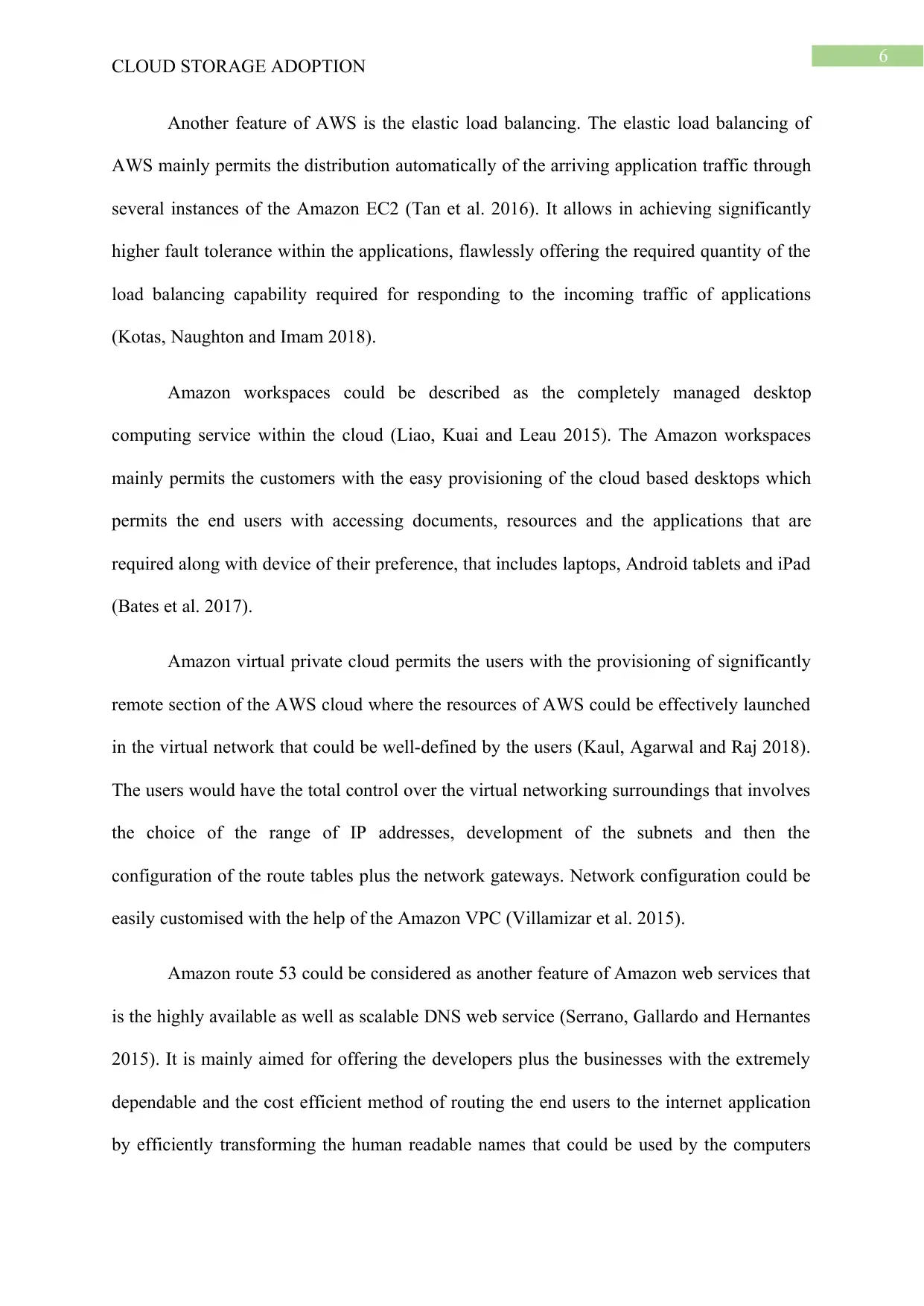
6
CLOUD STORAGE ADOPTION
Another feature of AWS is the elastic load balancing. The elastic load balancing of
AWS mainly permits the distribution automatically of the arriving application traffic through
several instances of the Amazon EC2 (Tan et al. 2016). It allows in achieving significantly
higher fault tolerance within the applications, flawlessly offering the required quantity of the
load balancing capability required for responding to the incoming traffic of applications
(Kotas, Naughton and Imam 2018).
Amazon workspaces could be described as the completely managed desktop
computing service within the cloud (Liao, Kuai and Leau 2015). The Amazon workspaces
mainly permits the customers with the easy provisioning of the cloud based desktops which
permits the end users with accessing documents, resources and the applications that are
required along with device of their preference, that includes laptops, Android tablets and iPad
(Bates et al. 2017).
Amazon virtual private cloud permits the users with the provisioning of significantly
remote section of the AWS cloud where the resources of AWS could be effectively launched
in the virtual network that could be well-defined by the users (Kaul, Agarwal and Raj 2018).
The users would have the total control over the virtual networking surroundings that involves
the choice of the range of IP addresses, development of the subnets and then the
configuration of the route tables plus the network gateways. Network configuration could be
easily customised with the help of the Amazon VPC (Villamizar et al. 2015).
Amazon route 53 could be considered as another feature of Amazon web services that
is the highly available as well as scalable DNS web service (Serrano, Gallardo and Hernantes
2015). It is mainly aimed for offering the developers plus the businesses with the extremely
dependable and the cost efficient method of routing the end users to the internet application
by efficiently transforming the human readable names that could be used by the computers
CLOUD STORAGE ADOPTION
Another feature of AWS is the elastic load balancing. The elastic load balancing of
AWS mainly permits the distribution automatically of the arriving application traffic through
several instances of the Amazon EC2 (Tan et al. 2016). It allows in achieving significantly
higher fault tolerance within the applications, flawlessly offering the required quantity of the
load balancing capability required for responding to the incoming traffic of applications
(Kotas, Naughton and Imam 2018).
Amazon workspaces could be described as the completely managed desktop
computing service within the cloud (Liao, Kuai and Leau 2015). The Amazon workspaces
mainly permits the customers with the easy provisioning of the cloud based desktops which
permits the end users with accessing documents, resources and the applications that are
required along with device of their preference, that includes laptops, Android tablets and iPad
(Bates et al. 2017).
Amazon virtual private cloud permits the users with the provisioning of significantly
remote section of the AWS cloud where the resources of AWS could be effectively launched
in the virtual network that could be well-defined by the users (Kaul, Agarwal and Raj 2018).
The users would have the total control over the virtual networking surroundings that involves
the choice of the range of IP addresses, development of the subnets and then the
configuration of the route tables plus the network gateways. Network configuration could be
easily customised with the help of the Amazon VPC (Villamizar et al. 2015).
Amazon route 53 could be considered as another feature of Amazon web services that
is the highly available as well as scalable DNS web service (Serrano, Gallardo and Hernantes
2015). It is mainly aimed for offering the developers plus the businesses with the extremely
dependable and the cost efficient method of routing the end users to the internet application
by efficiently transforming the human readable names that could be used by the computers
Paraphrase This Document
Need a fresh take? Get an instant paraphrase of this document with our AI Paraphraser
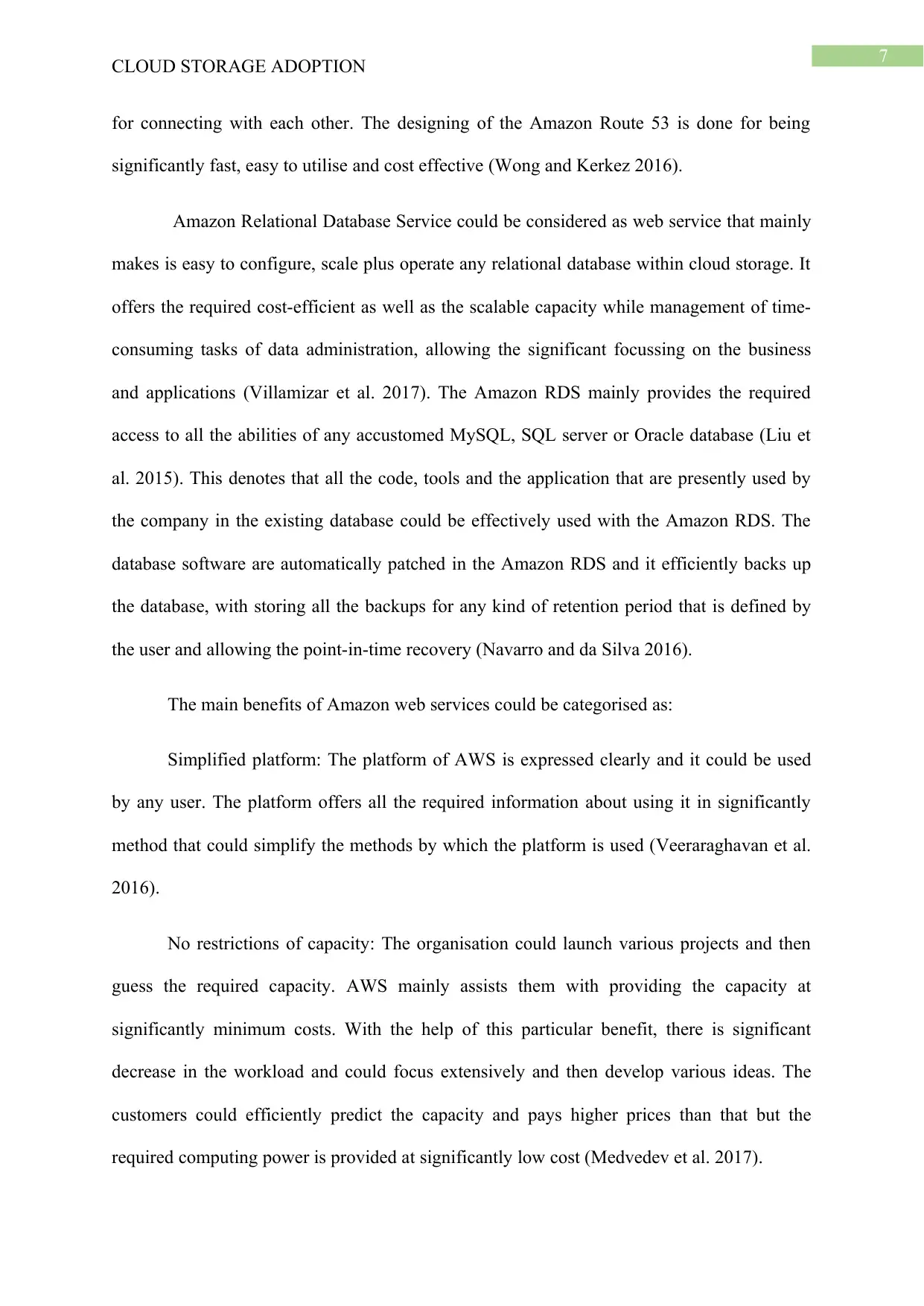
7
CLOUD STORAGE ADOPTION
for connecting with each other. The designing of the Amazon Route 53 is done for being
significantly fast, easy to utilise and cost effective (Wong and Kerkez 2016).
Amazon Relational Database Service could be considered as web service that mainly
makes is easy to configure, scale plus operate any relational database within cloud storage. It
offers the required cost-efficient as well as the scalable capacity while management of time-
consuming tasks of data administration, allowing the significant focussing on the business
and applications (Villamizar et al. 2017). The Amazon RDS mainly provides the required
access to all the abilities of any accustomed MySQL, SQL server or Oracle database (Liu et
al. 2015). This denotes that all the code, tools and the application that are presently used by
the company in the existing database could be effectively used with the Amazon RDS. The
database software are automatically patched in the Amazon RDS and it efficiently backs up
the database, with storing all the backups for any kind of retention period that is defined by
the user and allowing the point-in-time recovery (Navarro and da Silva 2016).
The main benefits of Amazon web services could be categorised as:
Simplified platform: The platform of AWS is expressed clearly and it could be used
by any user. The platform offers all the required information about using it in significantly
method that could simplify the methods by which the platform is used (Veeraraghavan et al.
2016).
No restrictions of capacity: The organisation could launch various projects and then
guess the required capacity. AWS mainly assists them with providing the capacity at
significantly minimum costs. With the help of this particular benefit, there is significant
decrease in the workload and could focus extensively and then develop various ideas. The
customers could efficiently predict the capacity and pays higher prices than that but the
required computing power is provided at significantly low cost (Medvedev et al. 2017).
CLOUD STORAGE ADOPTION
for connecting with each other. The designing of the Amazon Route 53 is done for being
significantly fast, easy to utilise and cost effective (Wong and Kerkez 2016).
Amazon Relational Database Service could be considered as web service that mainly
makes is easy to configure, scale plus operate any relational database within cloud storage. It
offers the required cost-efficient as well as the scalable capacity while management of time-
consuming tasks of data administration, allowing the significant focussing on the business
and applications (Villamizar et al. 2017). The Amazon RDS mainly provides the required
access to all the abilities of any accustomed MySQL, SQL server or Oracle database (Liu et
al. 2015). This denotes that all the code, tools and the application that are presently used by
the company in the existing database could be effectively used with the Amazon RDS. The
database software are automatically patched in the Amazon RDS and it efficiently backs up
the database, with storing all the backups for any kind of retention period that is defined by
the user and allowing the point-in-time recovery (Navarro and da Silva 2016).
The main benefits of Amazon web services could be categorised as:
Simplified platform: The platform of AWS is expressed clearly and it could be used
by any user. The platform offers all the required information about using it in significantly
method that could simplify the methods by which the platform is used (Veeraraghavan et al.
2016).
No restrictions of capacity: The organisation could launch various projects and then
guess the required capacity. AWS mainly assists them with providing the capacity at
significantly minimum costs. With the help of this particular benefit, there is significant
decrease in the workload and could focus extensively and then develop various ideas. The
customers could efficiently predict the capacity and pays higher prices than that but the
required computing power is provided at significantly low cost (Medvedev et al. 2017).
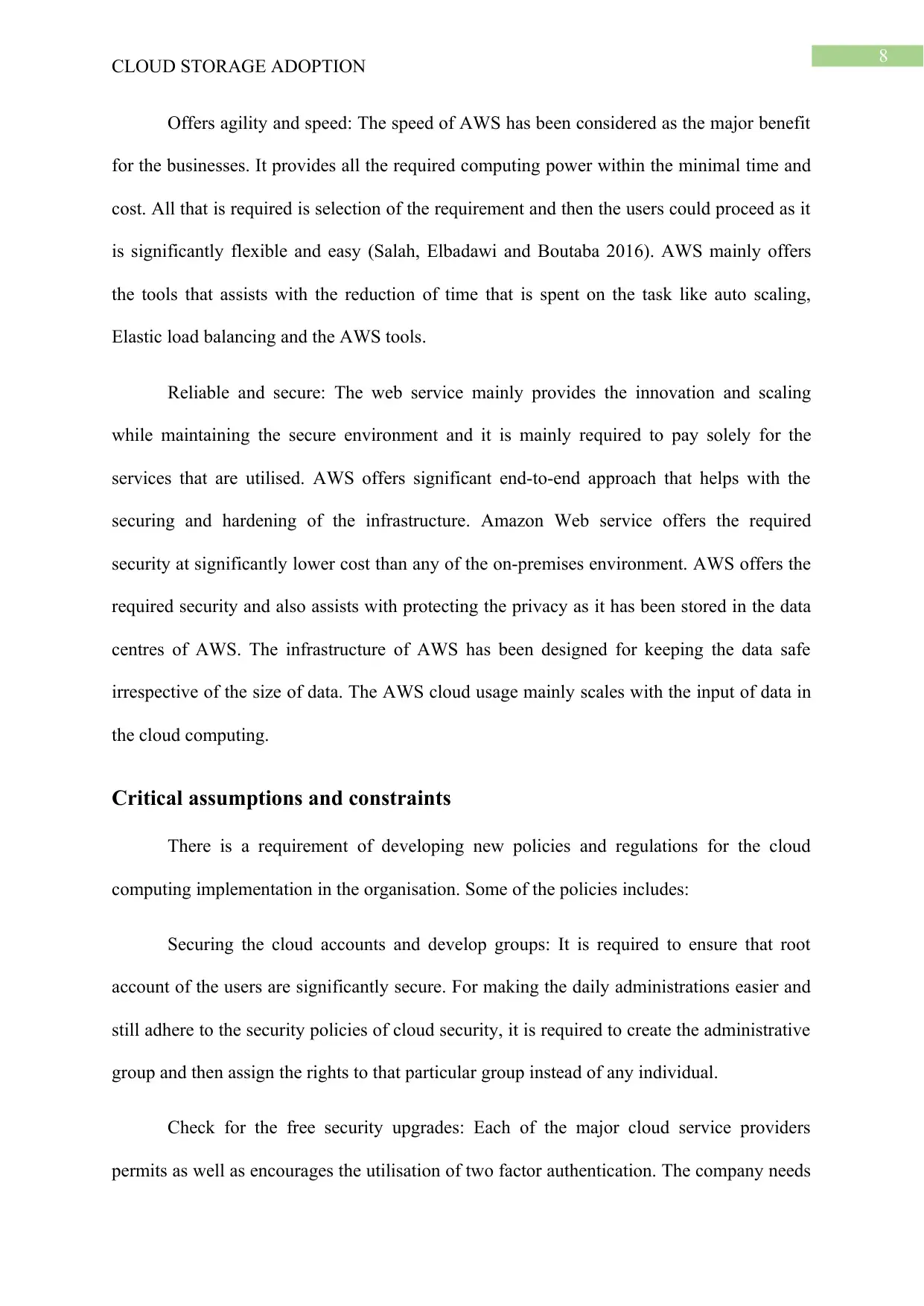
8
CLOUD STORAGE ADOPTION
Offers agility and speed: The speed of AWS has been considered as the major benefit
for the businesses. It provides all the required computing power within the minimal time and
cost. All that is required is selection of the requirement and then the users could proceed as it
is significantly flexible and easy (Salah, Elbadawi and Boutaba 2016). AWS mainly offers
the tools that assists with the reduction of time that is spent on the task like auto scaling,
Elastic load balancing and the AWS tools.
Reliable and secure: The web service mainly provides the innovation and scaling
while maintaining the secure environment and it is mainly required to pay solely for the
services that are utilised. AWS offers significant end-to-end approach that helps with the
securing and hardening of the infrastructure. Amazon Web service offers the required
security at significantly lower cost than any of the on-premises environment. AWS offers the
required security and also assists with protecting the privacy as it has been stored in the data
centres of AWS. The infrastructure of AWS has been designed for keeping the data safe
irrespective of the size of data. The AWS cloud usage mainly scales with the input of data in
the cloud computing.
Critical assumptions and constraints
There is a requirement of developing new policies and regulations for the cloud
computing implementation in the organisation. Some of the policies includes:
Securing the cloud accounts and develop groups: It is required to ensure that root
account of the users are significantly secure. For making the daily administrations easier and
still adhere to the security policies of cloud security, it is required to create the administrative
group and then assign the rights to that particular group instead of any individual.
Check for the free security upgrades: Each of the major cloud service providers
permits as well as encourages the utilisation of two factor authentication. The company needs
CLOUD STORAGE ADOPTION
Offers agility and speed: The speed of AWS has been considered as the major benefit
for the businesses. It provides all the required computing power within the minimal time and
cost. All that is required is selection of the requirement and then the users could proceed as it
is significantly flexible and easy (Salah, Elbadawi and Boutaba 2016). AWS mainly offers
the tools that assists with the reduction of time that is spent on the task like auto scaling,
Elastic load balancing and the AWS tools.
Reliable and secure: The web service mainly provides the innovation and scaling
while maintaining the secure environment and it is mainly required to pay solely for the
services that are utilised. AWS offers significant end-to-end approach that helps with the
securing and hardening of the infrastructure. Amazon Web service offers the required
security at significantly lower cost than any of the on-premises environment. AWS offers the
required security and also assists with protecting the privacy as it has been stored in the data
centres of AWS. The infrastructure of AWS has been designed for keeping the data safe
irrespective of the size of data. The AWS cloud usage mainly scales with the input of data in
the cloud computing.
Critical assumptions and constraints
There is a requirement of developing new policies and regulations for the cloud
computing implementation in the organisation. Some of the policies includes:
Securing the cloud accounts and develop groups: It is required to ensure that root
account of the users are significantly secure. For making the daily administrations easier and
still adhere to the security policies of cloud security, it is required to create the administrative
group and then assign the rights to that particular group instead of any individual.
Check for the free security upgrades: Each of the major cloud service providers
permits as well as encourages the utilisation of two factor authentication. The company needs
⊘ This is a preview!⊘
Do you want full access?
Subscribe today to unlock all pages.

Trusted by 1+ million students worldwide
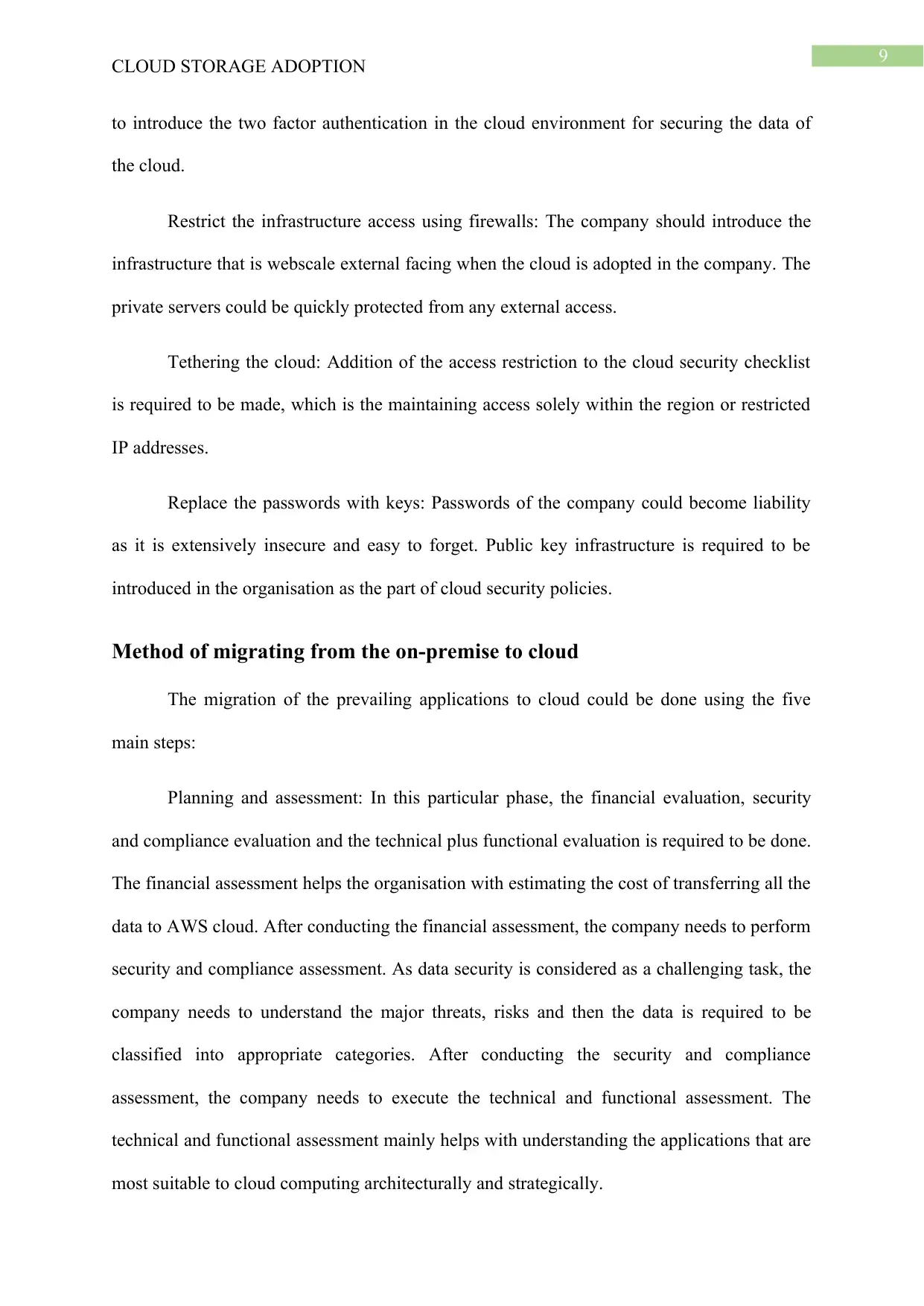
9
CLOUD STORAGE ADOPTION
to introduce the two factor authentication in the cloud environment for securing the data of
the cloud.
Restrict the infrastructure access using firewalls: The company should introduce the
infrastructure that is webscale external facing when the cloud is adopted in the company. The
private servers could be quickly protected from any external access.
Tethering the cloud: Addition of the access restriction to the cloud security checklist
is required to be made, which is the maintaining access solely within the region or restricted
IP addresses.
Replace the passwords with keys: Passwords of the company could become liability
as it is extensively insecure and easy to forget. Public key infrastructure is required to be
introduced in the organisation as the part of cloud security policies.
Method of migrating from the on-premise to cloud
The migration of the prevailing applications to cloud could be done using the five
main steps:
Planning and assessment: In this particular phase, the financial evaluation, security
and compliance evaluation and the technical plus functional evaluation is required to be done.
The financial assessment helps the organisation with estimating the cost of transferring all the
data to AWS cloud. After conducting the financial assessment, the company needs to perform
security and compliance assessment. As data security is considered as a challenging task, the
company needs to understand the major threats, risks and then the data is required to be
classified into appropriate categories. After conducting the security and compliance
assessment, the company needs to execute the technical and functional assessment. The
technical and functional assessment mainly helps with understanding the applications that are
most suitable to cloud computing architecturally and strategically.
CLOUD STORAGE ADOPTION
to introduce the two factor authentication in the cloud environment for securing the data of
the cloud.
Restrict the infrastructure access using firewalls: The company should introduce the
infrastructure that is webscale external facing when the cloud is adopted in the company. The
private servers could be quickly protected from any external access.
Tethering the cloud: Addition of the access restriction to the cloud security checklist
is required to be made, which is the maintaining access solely within the region or restricted
IP addresses.
Replace the passwords with keys: Passwords of the company could become liability
as it is extensively insecure and easy to forget. Public key infrastructure is required to be
introduced in the organisation as the part of cloud security policies.
Method of migrating from the on-premise to cloud
The migration of the prevailing applications to cloud could be done using the five
main steps:
Planning and assessment: In this particular phase, the financial evaluation, security
and compliance evaluation and the technical plus functional evaluation is required to be done.
The financial assessment helps the organisation with estimating the cost of transferring all the
data to AWS cloud. After conducting the financial assessment, the company needs to perform
security and compliance assessment. As data security is considered as a challenging task, the
company needs to understand the major threats, risks and then the data is required to be
classified into appropriate categories. After conducting the security and compliance
assessment, the company needs to execute the technical and functional assessment. The
technical and functional assessment mainly helps with understanding the applications that are
most suitable to cloud computing architecturally and strategically.
Paraphrase This Document
Need a fresh take? Get an instant paraphrase of this document with our AI Paraphraser

10
CLOUD STORAGE ADOPTION
Migration tools: The migration tools that could be used by the Telelink Company for
migrating the data to cloud are S3 command line interface, AWS import / export snowball,
AWS snowmobile, and Amazon Kinesis Firehose.
AWS cloud storage selection: As the Telelink Company needs storing plus querying
the structured relational as well as the referential data, the Amazon RDS is the most suitable
storage option for the company.
Migration strategies: The Forklift migration strategy is the most appropriate strategy
that could be used by the company. The self-sufficient applications, the tightly coupled
applications or the stateless applications may be served with improved manner by this
method.
Application migration method: The live migration could be considered as the most
appropriate application migration option for the company. The main feature of this migration
is that this is the process of transferring any running application from the physical machines
to the cloud deprived of disengaging the application. The memory, storage and the network
connectivity of this virtual machine are mainly replicated from the physical device to the
cloud.
Cost, investment and strategic opportunities
Cost type Costs
Strategic decision, choosing the cloud
computing services and cloud types
Expenditure of time (eot): 24h * $ 112 =
$2,688 Information for decision-making
(inf): $180
Assessment and choosing Service provider Expenditure of time (eot): 22h * 112 =
$2,464
Service charge SaaS Computing power (cp): 12mo * 0.16 * 740h
CLOUD STORAGE ADOPTION
Migration tools: The migration tools that could be used by the Telelink Company for
migrating the data to cloud are S3 command line interface, AWS import / export snowball,
AWS snowmobile, and Amazon Kinesis Firehose.
AWS cloud storage selection: As the Telelink Company needs storing plus querying
the structured relational as well as the referential data, the Amazon RDS is the most suitable
storage option for the company.
Migration strategies: The Forklift migration strategy is the most appropriate strategy
that could be used by the company. The self-sufficient applications, the tightly coupled
applications or the stateless applications may be served with improved manner by this
method.
Application migration method: The live migration could be considered as the most
appropriate application migration option for the company. The main feature of this migration
is that this is the process of transferring any running application from the physical machines
to the cloud deprived of disengaging the application. The memory, storage and the network
connectivity of this virtual machine are mainly replicated from the physical device to the
cloud.
Cost, investment and strategic opportunities
Cost type Costs
Strategic decision, choosing the cloud
computing services and cloud types
Expenditure of time (eot): 24h * $ 112 =
$2,688 Information for decision-making
(inf): $180
Assessment and choosing Service provider Expenditure of time (eot): 22h * 112 =
$2,464
Service charge SaaS Computing power (cp): 12mo * 0.16 * 740h
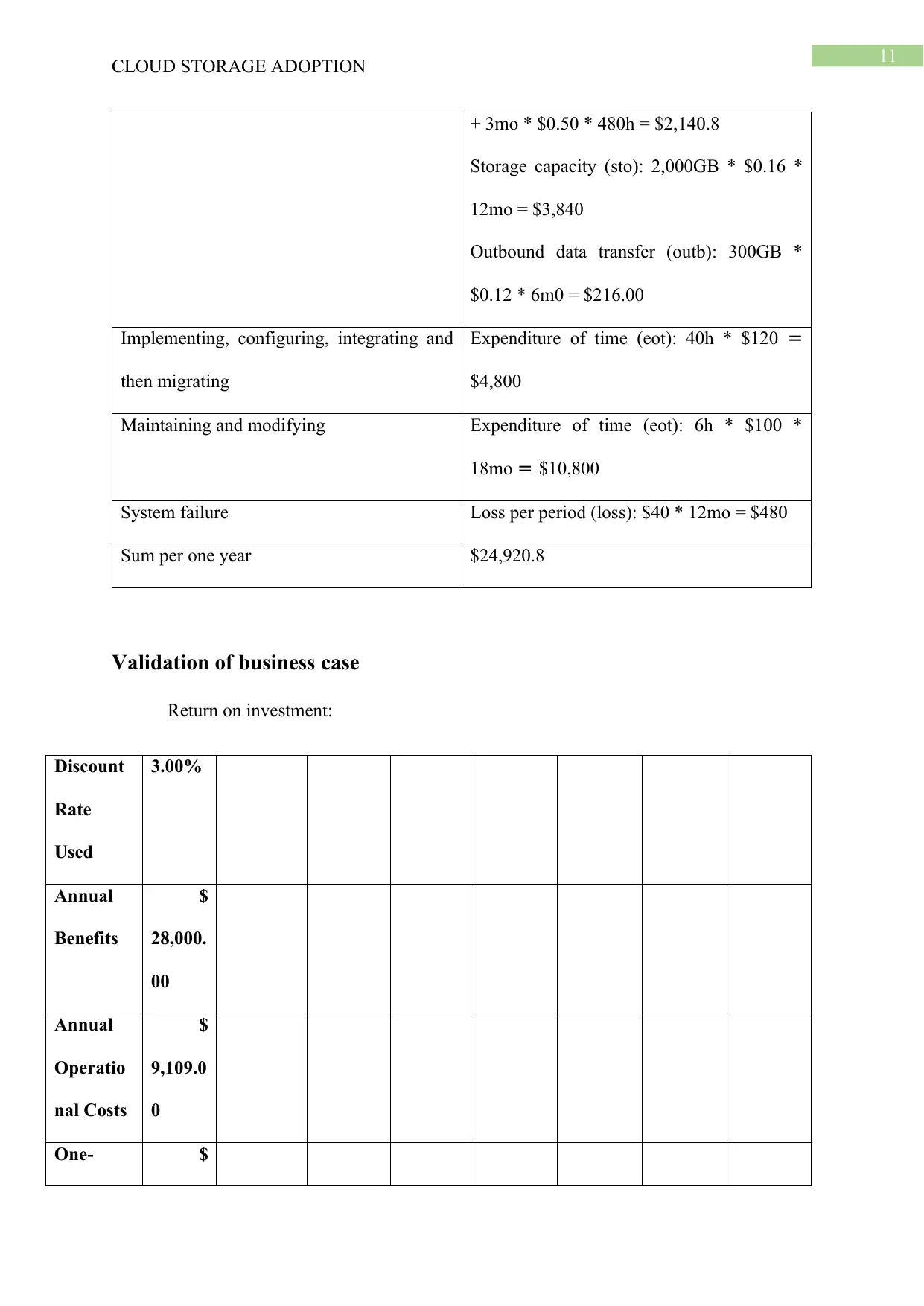
11
CLOUD STORAGE ADOPTION
+ 3mo * $0.50 * 480h = $2,140.8
Storage capacity (sto): 2,000GB * $0.16 *
12mo = $3,840
Outbound data transfer (outb): 300GB *
$0.12 * 6m0 = $216.00
Implementing, configuring, integrating and
then migrating
Expenditure of time (eot): 40h * $120 =
$4,800
Maintaining and modifying Expenditure of time (eot): 6h * $100 *
18mo = $10,800
System failure Loss per period (loss): $40 * 12mo = $480
Sum per one year $24,920.8
Validation of business case
Return on investment:
Discount
Rate
Used
3.00%
Annual
Benefits
$
28,000.
00
Annual
Operatio
nal Costs
$
9,109.0
0
One- $
CLOUD STORAGE ADOPTION
+ 3mo * $0.50 * 480h = $2,140.8
Storage capacity (sto): 2,000GB * $0.16 *
12mo = $3,840
Outbound data transfer (outb): 300GB *
$0.12 * 6m0 = $216.00
Implementing, configuring, integrating and
then migrating
Expenditure of time (eot): 40h * $120 =
$4,800
Maintaining and modifying Expenditure of time (eot): 6h * $100 *
18mo = $10,800
System failure Loss per period (loss): $40 * 12mo = $480
Sum per one year $24,920.8
Validation of business case
Return on investment:
Discount
Rate
Used
3.00%
Annual
Benefits
$
28,000.
00
Annual
Operatio
nal Costs
$
9,109.0
0
One- $
⊘ This is a preview!⊘
Do you want full access?
Subscribe today to unlock all pages.

Trusted by 1+ million students worldwide
1 out of 18
Related Documents
Your All-in-One AI-Powered Toolkit for Academic Success.
+13062052269
info@desklib.com
Available 24*7 on WhatsApp / Email
![[object Object]](/_next/static/media/star-bottom.7253800d.svg)
Unlock your academic potential
Copyright © 2020–2025 A2Z Services. All Rights Reserved. Developed and managed by ZUCOL.





